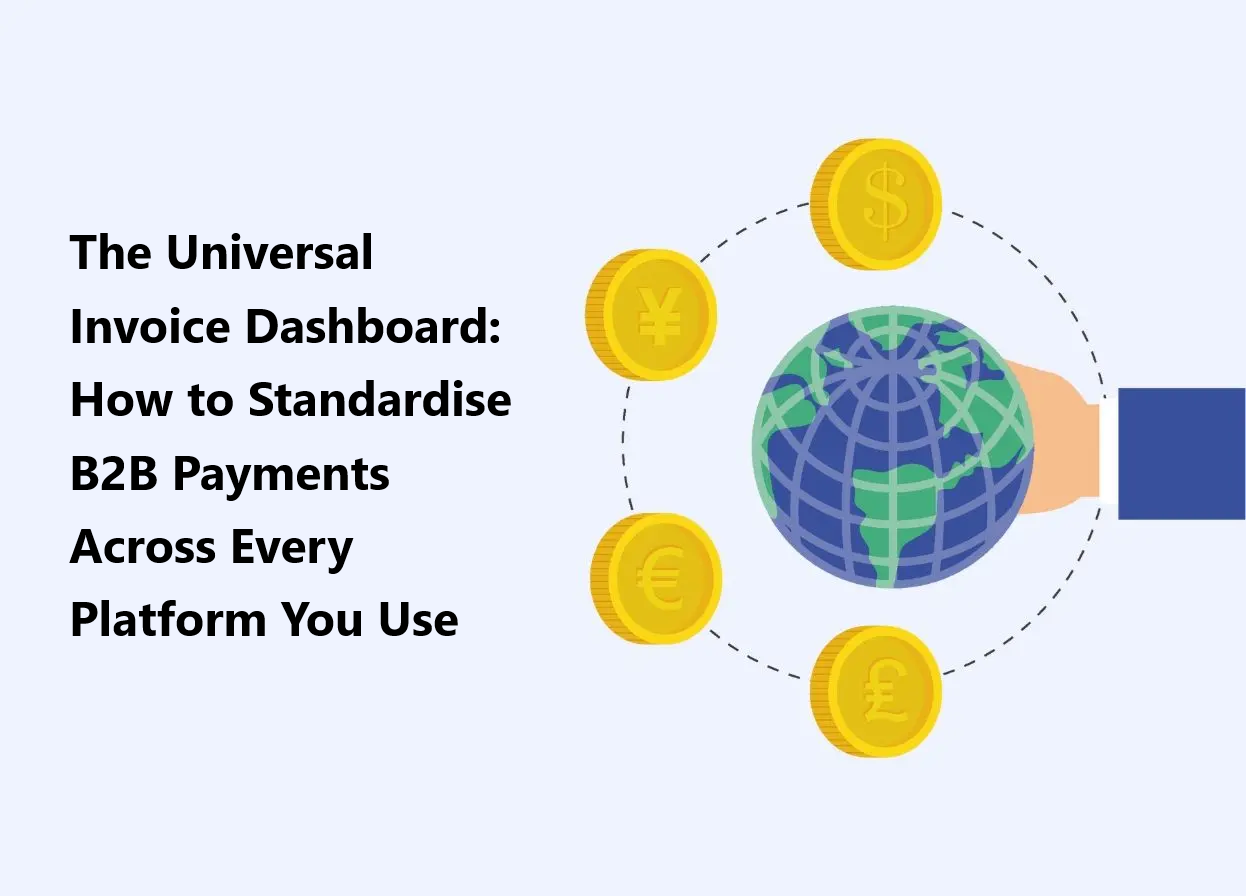
Open Banking for B2B Invoicing: One Dashboard for All Your Invoice Chaos
The Universal Invoice Dashboard: How to Standardise B2B Payments Across Every Platform You Use
Picture your current invoicing reality: Sarah in accounting uses QuickBooks. The sales team bills through HubSpot. Marketing runs payments through Stripe. The website processes orders via WooCommerce. The consulting team invoices from Monday.com. Each system speaks its own language, and you’re the translator trying to make sense of Babel.
This isn’t just inefficient – it’s dangerous. When invoices live in silos, you don’t know your true cash position, can’t spot problem customers, and miss critical patterns that could save or make you thousands.
The Real Cost of Invoice Fragmentation
Let’s quantify the chaos:
- Reconciliation Multiplier: Each system needs separate reconciliation. Five systems = 5x the work
- Missed Payments: 3-5% of payments get lost between systems
- Duplicate Invoicing: 2% of customers get billed twice when systems don’t communicate
- Decision Delays: Real cash position unknown until monthly consolidation
- Customer Confusion: Different invoice formats, payment methods, and terms per system
For a typical mid-size B2B company, this fragmentation costs £75,000-£100,000 annually in extra labour, errors, and missed opportunities.
Ready to let AI protect your procurement?
Contact Systematics Software Ltd today to explore how AI-powered solutions can revolutionise your operations and prepare you for the future of technology.
Nam aliquet ante porta, gravida elit, at fringilla felis suscipit.
The Unified Dashboard Revolution
Here’s the breakthrough: We create solutions where you enter information once and it flows everywhere it needs to go. Plus, we connect all your existing business systems – payments, banking, accounting, CRM, e-commerce platforms – so they actually communicate and share relevant data automatically.
This isn’t about replacing your systems. It’s about making them work together.
What Lives in Your Unified Dashboard
Imagine logging into one screen that shows:
From Your Accounting Software (QuickBooks, Xero, Sage):
- Traditional invoices with terms and ageing
- Credit notes and adjustments
- Recurring billing schedules
From Your CRM (Salesforce, HubSpot, Pipedrive):
- Quote-to-invoice conversions
- Subscription renewals
- Contract-based billing
From Payment Processors (Stripe, PayPal, Square):
- Online payment transactions
- Subscription charges
- Failed payment attempts
From E-commerce Platforms (Shopify, WooCommerce, BigCommerce):
- Order invoices
- Refunds and returns
- Partial shipment billing
From Custom Systems (Your proprietary platform, industry-specific tools):
- Specialised billing arrangements
- Complex multi-party invoices
- Project-based progressive billing
All standardised into one consistent format. All updated in real-time. All reconciled automatically.
The Standardisation Magic
Standardisation isn’t just about pretty formatting. It’s about making data comparable and actionable:
Unified Customer View: John Smith in QuickBooks, J.Smith in Stripe, and Smith Holdings in your CRM are recognised as the same customer. Their complete payment history across all platforms appears in one profile.
Consistent Status Tracking: “Paid” means the same thing whether it’s from PayPal or your bank. “Overdue” triggers the same workflows regardless of source system.
Normalised Data Fields: Different systems call things different names. Your dashboard translates:
- “Invoice Date” vs “Bill Date” vs “Transaction Date” → Standardised as “Invoice Date”
- “Customer” vs “Client” vs “Account” → Unified as “Customer”
- “Amount Due” vs “Balance” vs “Outstanding” → Shown as “Outstanding Amount”
Common Calculations: Ageing, DSO, payment patterns – calculated consistently across all invoice sources.
Ready to deploy AI protection across your procurement?
Contact Systematics Software Ltd today to explore how AI-powered solutions can revolutionise your operations and prepare you for the future of technology.
Nam aliquet ante porta, gravida elit, at fringilla felis suscipit.
How Open Banking Completes the Picture
The unified dashboard shows what should happen. Open Banking shows what actually happened. When these connect:
- Automatic Matching: Payment arrives in your bank → Open Banking feed captures it → Dashboard matches it to the correct invoice → Updates propagate to source system
- Intelligent Reconciliation: Dashboard knows Customer ABC usually pays Stripe invoices by card but Xero invoices by bank transfer. It matches accordingly.
- Real-Time Updates: Payment status changes instantly across all connected systems. No more checking multiple platforms to confirm payment.
- Exception Management: Partial payments, overpayments, and unallocated receipts are flagged immediately with suggested matches.
The Implementation Journey
Week 1: Foundation
- Map all your invoicing systems (you’ll be surprised how many you find)
- Connect Open Banking feeds
- Establish data standardisation rules
- Create unified customer master list
Week 2: Integration
- Connect accounting platforms via API
- Link CRM systems
- Integrate payment processors
- Connect e-commerce platforms
Week 3: Intelligence
- Set up matching rules
- Configure reconciliation workflows
- Implement exception handling
- Create role-based dashboards
Week 4: Optimisation
- Train AI on your payment patterns
- Set up automated alerts
- Create custom reports
- Enable predictive analytics
Real-World Transformations
Digital Agency (15 invoicing sources): Consolidated Xero, Stripe, PayPal, HubSpot, and 11 other systems. Result: Reduced month-end close from 5 days to 4 hours.
Manufacturing Distributor (7 platforms): Unified SAP, Salesforce, Magento, and various payment systems. Discovery: 12% of invoices were being paid but not marked as received due to system disconnection.
SaaS Company (9 billing systems): Standardised across Recurly, Stripe, QuickBooks, and multiple regional platforms. Outcome: Identified £250,000 in unbilled services hidden between systems.
The Power Features You Didn’t Know You Needed
Duplicate Detection: AI spots when the same service is invoiced through multiple systems.
Currency Normalisation: Invoices in different currencies display in your base currency with real-time conversion.
Tax Reconciliation: VAT, GST, sales tax from different systems consolidated for reporting.
Approval Workflows: Invoice approvals work the same regardless of originating system.
Audit Trail: Complete history of every invoice from creation through payment, regardless of platform.
Breaking Down the Objections
“Our systems are too different” – That’s exactly why you need standardisation. The more varied your systems, the more value from unification.
“We need to keep systems separate for compliance” – Unification doesn’t mean consolidation. Original systems maintain their data; you just get a unified view.
“This sounds complex” – It’s complex once during setup, then simple forever. Compare that to complex manual reconciliation every single day.
The Strategic Advantages
When invoice chaos becomes organised intelligence:
Customer Intelligence: See total customer value across all touchpoints, not just per system.
Revenue Recognition: Understand true revenue timing, not just when invoices were created.
Credit Decisions: Make informed credit decisions based on complete payment history.
Forecasting Accuracy: Predict cash flow based on all revenue streams, not just the ones in your accounting system.
The Bottom Line
Every day you operate without a unified invoice dashboard, you’re making decisions on partial information. You’re wasting hours on reconciliation. You’re missing patterns that could transform your business.
The technology exists. The integrations are available. The only question is: How much longer will you accept invoice chaos as normal?




